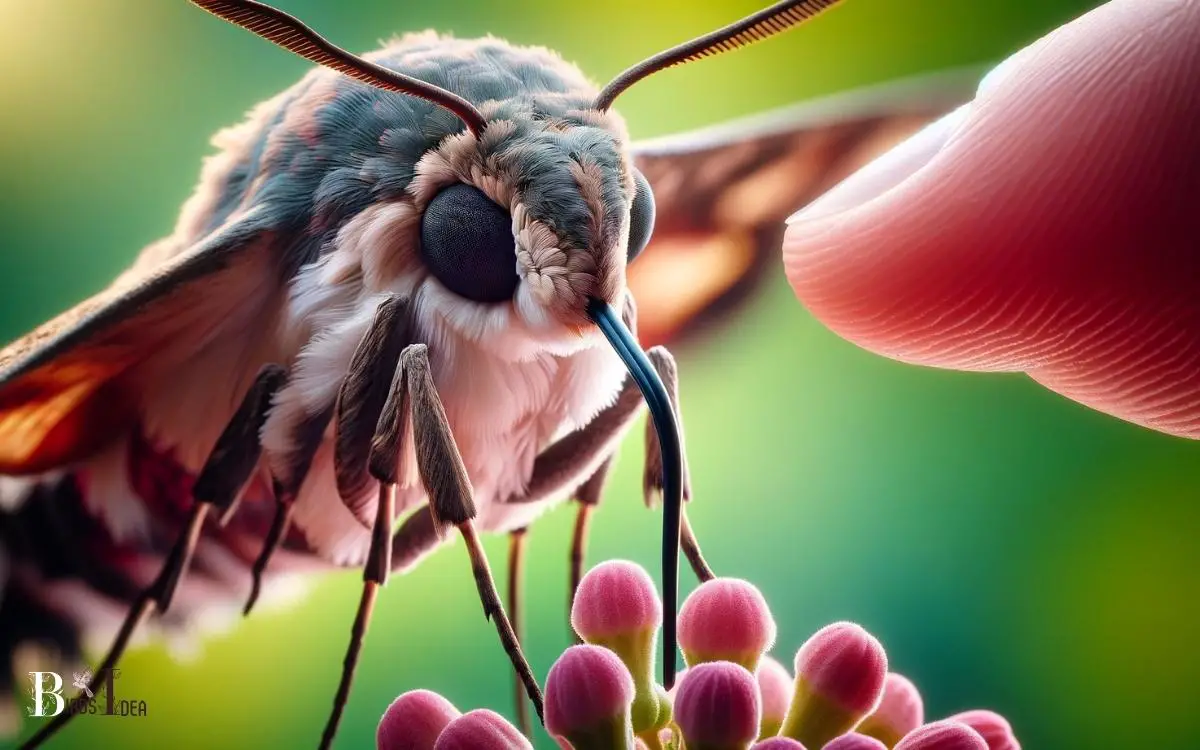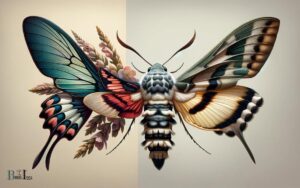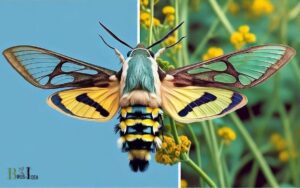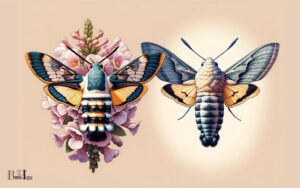Hummingbird Moth Do They Bite: No!
No, Hummingbird Moths do not bite humans. They lack the mouthparts necessary for biting as they feed exclusively on nectar.
Hummingbird Moths, often mistaken for hummingbirds due to their hovering behavior, possess a specialized proboscis adapted for sipping nectar from flowers.
Unlike mosquitoes or other biting insects, their mouthparts are designed for feeding on floral nectar, making them incapable of biting humans or other animals.
Their primary focus is on pollination and nectar consumption, contributing positively to the ecosystem.
While they may occasionally land on a person, it’s not an aggressive behavior, and they pose no threat.
Their gentle nature and non-biting characteristics make them harmless and fascinating creatures to observe in gardens and natural settings.
Hummingbird Moths do not bite, and their interactions with humans are centered around their quest for nectar, making them harmless and beneficial pollinators in the natural world.

Key Takeaway
Identifying Hummingbird Moths
How can one distinguish a hummingbird moth from other similar-looking insects?
Hummingbird moths, scientifically known as Hemaris, bear a striking resemblance to hummingbirds in both appearance and behavior.
They’re often mistaken for hummingbirds due to their rapid wingbeats and hovering flight patterns while feeding on nectar from flowers.
However, upon closer examination, several key features can help differentiate them from their avian counterparts.
Hummingbird moths have clear wings with a distinct dark band across the center, unlike most other moths. Additionally, they’ve a streamlined body and a long, protruding proboscis used for feeding.
These characteristics set them apart from other insects and birds, making them a unique and fascinating species to observe.
This distinction is important as it sets the stage for understanding their similarities to hummingbirds.
Feeding and Behavior Patterns
Hummingbird moths exhibit diurnal behavior patterns and feed primarily on the nectar of flowers.
They are most active during the day, especially during the warmest hours when flowers are in full bloom.
Their feeding and behavior patterns are fascinating and distinct.
- Nectar Feeding: Hummingbird moths use their long proboscis to reach deep into flowers and drink nectar, much like hummingbirds.
- Hovering: They hover in front of flowers while feeding, their wings beating rapidly to maintain position, resembling the behavior of hummingbirds.
- Flight Patterns: Their flight patterns are agile and swift, allowing them to move quickly from flower to flower in search of nectar sources.
These feeding and behavior patterns enable hummingbird moths to efficiently collect nectar while exhibiting remarkable similarities to hummingbirds.
Defense Mechanisms
Known for their remarkable agility and swift flight patterns, hummingbird moths defend themselves from predators using a combination of rapid aerial maneuvers and their ability to mimic the appearance and behavior of a more threatening species.
When threatened, these moths are capable of quick, evasive flight movements, making it challenging for predators to capture them. Additionally, their physical resemblance to hummingbirds aids in their defense.
With similar coloring, body shape, and hovering behavior, they create a misleading impression of being a potentially harmful target. This mimicry helps deter predators that may perceive hummingbirds as challenging prey.
Furthermore, their swift and erratic flight patterns closely resemble those of hummingbirds, further confusing predators.
These defense mechanisms allow hummingbird moths to evade predation and thrive in their natural habitats.
Interaction With Humans
The interaction of hummingbird moths with humans is a subject that raises questions about their behavior and potential impact on human safety.
Understanding the behaviors of these moths can help prevent potential harm and alleviate concerns about their presence.
It’s important to explore how to coexist with these fascinating creatures while ensuring the safety of both humans and the moths themselves.
Hummingbird Moth Behavior
When encountering humans, hummingbird moths tend to exhibit cautious yet curious behavior. They may approach humans closely, especially if the human is still or moving slowly.
Here are three key behaviors to note:
- Curiosity: Hummingbird moths are often curious and may hover around humans, especially if they’re near flowers or other sources of nectar.
- Caution: While curious, these moths are also cautious and will typically maintain a safe distance from humans. Sudden movements or attempts to touch them may startle or scare them away.
- Fearlessness: Despite their caution, hummingbird moths can be quite fearless in their interactions with humans, often appearing unbothered by human presence.
Understanding these behaviors can help humans appreciate and coexist harmoniously with these fascinating creatures.
Human Safety Concerns
Interactions with hummingbird moths rarely result in bites, posing minimal risk to humans. These moths, often mistaken for hummingbirds due to their similar appearance and hovering behavior, are primarily focused on feeding from flowers using their long proboscis.
While they may occasionally land on a person to rest, they don’t view humans as a food source or a threat, and therefore, don’t pose a significant danger.
However, it’s important to note that like all wild animals, they may react defensively if they feel threatened or cornered. In such cases, they may flutter erratically or try to fly away.
As a general precaution, it’s advisable to avoid handling hummingbird moths, but overall, they’re harmless and don’t present a significant safety concern for humans.
Preventing Potential Harm
Avoiding direct contact with hummingbird moths is essential for minimizing any potential risk of harm during human interactions with these creatures.
While these moths are generally harmless, it’s important to take precautions to prevent any unwanted encounters.
To prevent potential harm when dealing with hummingbird moths, individuals should consider the following:
- Do not try to touch or handle them: Hummingbird moths may perceive human contact as a threat, leading them to react defensively.
- Avoid startling or swatting at them: Sudden movements can agitate the moth, potentially leading to accidental contact and causing unnecessary stress.
- Provide a safe distance: Observing these creatures from a respectful distance can help minimize the risk of accidental contact and ensure their natural behavior remains undisturbed.
Can Hummingbird Moths Abandon Their Young?
Some mother hummingbirds and baby abandonment concerns have been raised regarding hummingbird moths. These moths, while resembling hummingbirds in appearance and behavior, do not exhibit parental care. Instead, they lay eggs and leave their offspring to develop on their own. Thus, they do not abandon their young but rather do not have the same caregiving instincts as mother hummingbirds.
Myth Busting: Do They Bite?
The hummingbird moth rarely bites humans, preferring to feed on nectar from flowers. Despite their ability to buzz around humans and other animals, they are not aggressive and do not seek to feed on blood.
To further understand the behavior of the hummingbird moth, consider the following table:
| Myth | Fact | Explanation |
|---|---|---|
| Hummingbird moths are aggressive biters | Hummingbird moths are not aggressive and rarely bite humans | Their primary goal is to feed on nectar from flowers |
| Hummingbird moths pose a threat to humans | Hummingbird moths are harmless to humans | They do not possess the mouthparts to bite or sting |
| Hummingbird moths carry diseases | Hummingbird moths do not transmit diseases to humans | Their feeding habits do not involve contact with humans or human-related environments |
Understanding the myths and facts about hummingbird moths can help dispel any unnecessary fears or concerns about potential bites.
Conclusion
Hummingbird moths are fascinating creatures that closely resemble hummingbirds in appearance and behavior. Despite their similarities, they don’t bite and pose no threat to humans.
Their unique defense mechanisms and feeding patterns make them an interesting subject of study for entomologists and nature enthusiasts alike.
Just as the moth’s wings flutter gracefully, so too does its presence evoke a sense of wonder and awe in those who encounter it.






